Scuba diving locations unveil a captivating realm beneath the surface, beckoning adventurers to immerse themselves in the pristine beauty and boundless mysteries of the underwater world. From renowned destinations to hidden gems, this narrative embarks on an exploration of the most alluring scuba diving sites, inviting readers to discover the wonders that lie beneath the waves.
Prepare to dive into a world of vibrant coral reefs teeming with life, encounter majestic marine creatures, and witness the awe-inspiring underwater landscapes that make scuba diving an unforgettable experience.
Popular Scuba Diving Destinations
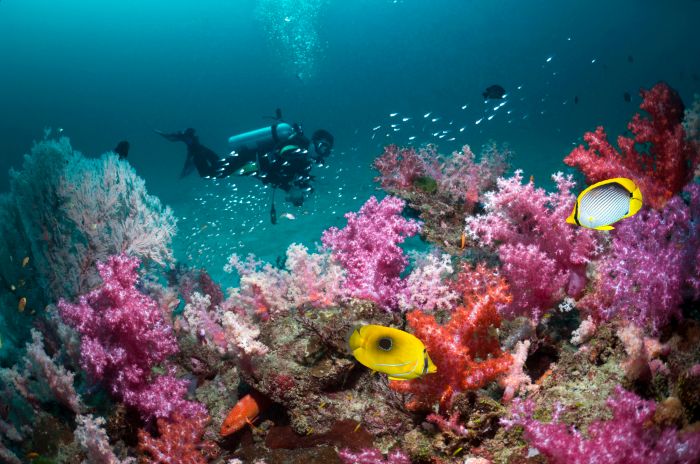
Scuba diving offers an extraordinary opportunity to explore the captivating underwater world, teeming with diverse marine life and breathtaking landscapes. Across the globe, numerous destinations have gained prominence for their exceptional scuba diving experiences.
The following table showcases some of the most renowned scuba diving locations worldwide, highlighting their unique features and regional significance:
| Location | Region | Unique Features |
|---|---|---|
| Great Barrier Reef | Australia | World’s largest coral reef system, home to an astonishing array of marine life. |
| Red Sea | Egypt | Crystal-clear waters, spectacular coral formations, and abundant fish species. |
| Maldives | Indian Ocean | Overwater bungalows, pristine atolls, and vibrant marine ecosystems. |
| Cocos Island | Costa Rica | Remote and pristine, renowned for hammerhead shark encounters and underwater seamounts. |
| Galapagos Islands | Ecuador | Unparalleled biodiversity, including sea lions, marine iguanas, and whale sharks. |
Hidden Gems for Scuba Diving

Beyond the well-trodden paths of popular scuba diving destinations, there lies a world of hidden gems waiting to be explored. These lesser-known spots offer captivating underwater experiences, pristine reefs, and unique marine life encounters.
Unveiling these hidden treasures, we present a curated list of these captivating scuba diving destinations, each boasting distinctive qualities that will leave you spellbound.
Sipadan Island, Malaysia
- Renowned for its incredible biodiversity, Sipadan is home to over 3,000 species of fish and hundreds of coral species.
- Divers can encounter large schools of barracuda, turtles, sharks, and a plethora of vibrant reef fish.
- The island’s unique geography, including sheer walls and coral-encrusted pinnacles, creates a mesmerizing underwater landscape.
Raja Ampat, Indonesia
- An archipelago of over 1,500 islands, Raja Ampat boasts an astounding 75% of the world’s coral species.
- Divers can explore pristine reefs teeming with colorful marine life, including pygmy seahorses, manta rays, and wobbegong sharks.
- The region’s underwater topography offers a diverse range of dive sites, from shallow coral gardens to deep walls and seamounts.
Cocos Island, Costa Rica
- Located over 300 miles off the Pacific coast of Costa Rica, Cocos Island is a remote paradise for scuba divers.
- The island’s pristine waters are home to large populations of hammerhead sharks, dolphins, and sea turtles.
- Divers can explore underwater caves, seamounts, and deep walls, encountering a wide variety of marine species.
Lord Howe Island, Australia
- A UNESCO World Heritage site, Lord Howe Island is renowned for its pristine marine environment and abundant marine life.
- Divers can witness large schools of kingfish, grey nurse sharks, and leopard sharks patrolling the island’s fringing reefs.
- The island’s unique underwater topography, including volcanic pinnacles and coral-covered walls, creates a captivating diving experience.
Truk Lagoon, Micronesia
- Once the site of a major Japanese naval base during World War II, Truk Lagoon is now a world-renowned wreck diving destination.
- Divers can explore over 60 sunken ships, including battleships, aircraft carriers, and submarines, creating an eerie and fascinating underwater landscape.
- The lagoon’s clear waters and abundant marine life make it a captivating destination for both wreck enthusiasts and underwater photographers.
Choosing the Ideal Scuba Diving Location

Selecting the perfect scuba diving location is crucial for an unforgettable experience. Consider the following factors to make an informed decision:
Experience Level
- Beginners: Opt for shallow, sheltered waters with calm currents and good visibility, such as the Great Barrier Reef in Australia or the Red Sea in Egypt.
- Intermediate: Explore sites with moderate depths, some current, and diverse marine life, such as the Galapagos Islands in Ecuador or the Komodo National Park in Indonesia.
- Advanced: Seek out deep wrecks, underwater caves, or strong currents, such as the Blue Hole in Belize or the Sipadan Island in Malaysia.
Interests and Preferences
- Marine Life Enthusiasts: Choose destinations renowned for their abundance and variety of marine life, such as the Raja Ampat in Indonesia or the Socorro Islands in Mexico.
- Wreck Divers: Visit locations with historical or modern shipwrecks, such as the USS Arizona in Hawaii or the SS Thistlegorm in the Red Sea.
- Coral Lovers: Explore sites with vibrant and healthy coral reefs, such as the Maldives or the Great Barrier Reef.
Planning a Scuba Diving Trip
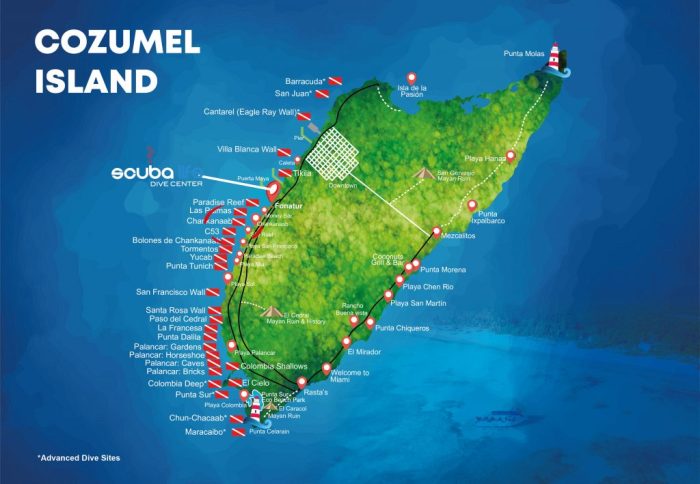
Planning a scuba diving trip requires meticulous attention to detail. From choosing the right dive operator to booking accommodations and packing the essential gear, a comprehensive approach ensures a safe and enjoyable experience.
Choosing a Dive Operator
Selecting a reputable dive operator is paramount. Research online reviews, check certifications, and inquire about the operator’s experience and safety protocols. Consider the size of the groups, the types of dives offered, and the level of supervision provided. A reputable operator will prioritize safety, provide well-maintained equipment, and have a proven track record of customer satisfaction.
Booking Accommodations
Consider the proximity of your accommodations to the dive sites. Look for hotels or guesthouses that offer amenities such as dive storage, equipment rentals, and transportation to and from the dive boat. Check for availability, read reviews, and compare prices to find the best option that suits your needs and budget.
Packing Essentials
Pack essential diving gear, including a wetsuit or drysuit, mask, fins, snorkel, and buoyancy compensator device (BCD). Ensure that all equipment is in good working condition and fits properly. Bring a first-aid kit, sunscreen, and hydration supplies. Consider packing a dive computer to monitor depth, time, and air consumption. For extended trips, pack extra batteries, torches, and spare parts for critical equipment.
Safety Considerations for Scuba Diving
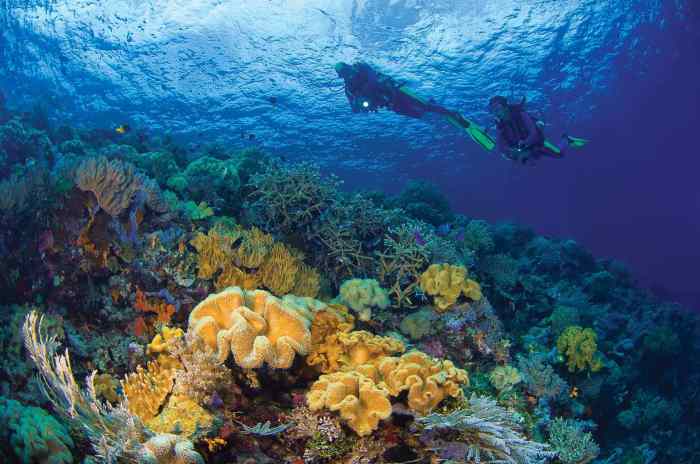
Embarking on a scuba diving adventure can be incredibly exhilarating, but it’s imperative to prioritize safety throughout your journey. Scuba diving requires proper training, meticulous equipment maintenance, and thorough dive planning to ensure a safe and enjoyable experience.
Essential Safety Measures
- Obtain Proper Training: Acquire certification from a reputable diving organization. This training will equip you with the knowledge, skills, and emergency procedures necessary for safe diving.
- Maintain Equipment Regularly: Ensure your scuba gear is in pristine condition before every dive. This includes inspecting your regulator, buoyancy compensator device, and tank for any signs of damage or leaks.
- Plan Dives Meticulously: Familiarize yourself with the dive site, including its depth, currents, and potential hazards. Determine a dive plan that aligns with your experience level and the conditions.
- Follow the Buddy System: Dive with a partner and maintain visual contact throughout the dive. This allows you to assist each other in case of emergencies.
- Respect Your Limits: Understand your physical and mental capabilities. Avoid diving beyond your training or experience level, and never dive alone.
Environmental Impact of Scuba Diving
Scuba diving, while a thrilling and immersive experience, has the potential to impact marine ecosystems if not conducted responsibly. Understanding and mitigating these impacts is crucial for preserving the health and beauty of our underwater world.
Uncontrolled diving practices can damage fragile coral reefs, disturb marine life, and contribute to pollution. It’s essential to adopt responsible diving practices to minimize our footprint and ensure the sustainability of these ecosystems.
Responsible Practices for Minimizing Environmental Impact
- Buoyancy Control: Maintaining proper buoyancy prevents contact with the seafloor and damage to marine life.
- Avoid Touching Marine Life: Resist the temptation to touch or handle marine animals, as it can stress or harm them.
- Proper Waste Disposal: Always dispose of waste responsibly, either on land or in designated containers underwater.
- Respect Marine Protected Areas: Adhere to regulations and avoid diving in restricted areas to protect sensitive ecosystems.
- Support Sustainable Operators: Choose dive operators that prioritize environmental conservation and educate their clients about responsible diving practices.
Scuba Diving for Beginners
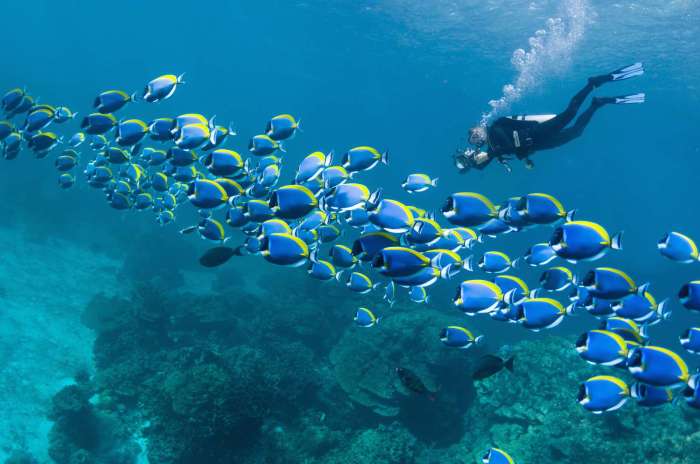
Scuba diving is an exciting and rewarding sport that allows you to explore the underwater world. If you’re new to scuba diving, there are a few things you need to know to get started.
Basics of Scuba Diving
Scuba diving involves using specialized equipment to breathe underwater. The basic equipment includes a diving mask, snorkel, fins, buoyancy compensator device (BCD), scuba tank, and regulator. You’ll also need to complete a training course to learn the basics of scuba diving, including how to use the equipment, how to communicate underwater, and how to stay safe.
Training and Certification
There are several different scuba diving training organizations, such as PADI, SSI, and NAUI. Each organization offers a variety of training courses, from beginner to advanced. Once you complete a training course, you’ll receive a certification card that proves you’re qualified to scuba dive.
Safety Procedures
Scuba diving is a safe sport, but there are some risks involved. It’s important to follow all safety procedures to minimize the risk of an accident. Some of the most important safety procedures include:
– Never dive alone.
– Always dive with a buddy.
– Check your equipment before each dive.
– Stay within your depth limits.
– Don’t dive if you’re not feeling well.
– Respect the marine environment.
Advanced Scuba Diving Techniques
Experienced divers can expand their horizons by pursuing advanced scuba diving techniques. These specialized skills open up new underwater experiences and challenges.
Deep Diving
Deep diving involves descending beyond recreational limits, typically below 130 feet (40 meters). It requires specialized training and equipment to manage the increased pressure and potential risks.
- Divers must understand decompression procedures to avoid decompression sickness.
- They use specialized gas mixtures to reduce nitrogen absorption.
- Deep diving exposes divers to cold temperatures and limited visibility.
Wreck Diving
Wreck diving involves exploring sunken ships or aircraft underwater. It requires specialized skills to navigate safely through the wreckage and avoid entanglement.
- Divers must be able to assess the stability of the wreck and plan their penetration.
- They need to be aware of potential hazards such as sharp metal, broken glass, and strong currents.
- Wreck diving can provide insights into maritime history and underwater archaeology.
Cave Diving
Cave diving involves exploring underwater caves, which offer unique challenges and rewards. It requires specialized training and equipment to navigate the complex and confined spaces.
For those seeking adventure beneath the waves, the world’s top scuba diving locations offer an unforgettable experience. Whether you’re a seasoned diver or just starting out, there’s something for everyone. From the vibrant coral reefs of the Maldives to the historic shipwrecks of the Mediterranean, there are countless destinations to explore.
Discover the best of the best with our guide to the best travel destinations 2024 for scuba diving.
- Divers must be proficient in buoyancy control and line management.
- They need to be able to handle limited visibility and potential silt-outs.
- Cave diving can reveal hidden underwater formations, fossils, and unique ecosystems.
Underwater Photography and Videography
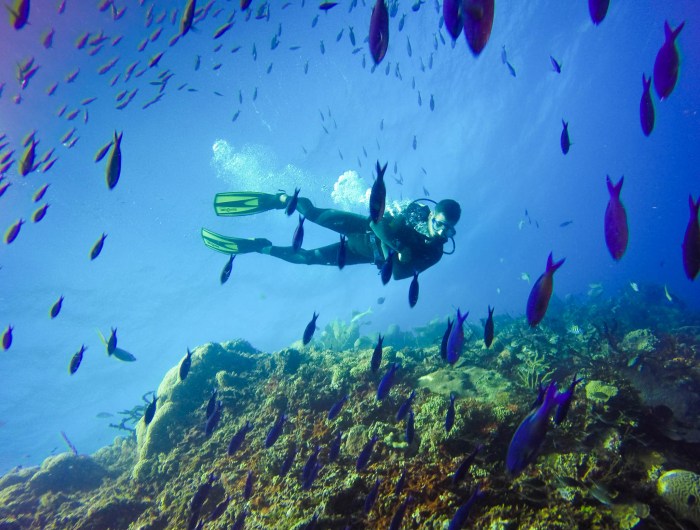
The underwater world offers a mesmerizing canvas for capturing stunning images and videos. Underwater photography and videography have become popular pursuits for divers who seek to document the beauty and diversity of the marine environment.
To excel in underwater photography and videography, it is crucial to understand the unique challenges and techniques involved. This includes selecting the appropriate equipment, mastering camera settings, and employing post-processing techniques to enhance the captured content.
Scuba diving is an unforgettable experience that can create lasting memories for families. However, it can also be expensive. If you’re looking for a budget-friendly way to enjoy this incredible activity, consider planning a budget family vacation to a destination with affordable diving options.
Many locations offer excellent scuba diving opportunities at a fraction of the cost of more popular tourist spots.
Equipment Selection
Choosing the right equipment is essential for successful underwater photography and videography. Consider factors such as camera type, lens options, underwater housing, and lighting.
- Camera Type: Mirrorless cameras and DSLRs offer interchangeable lenses and manual controls, providing greater flexibility and image quality.
- Lens Options: Wide-angle lenses capture expansive scenes, while macro lenses allow for close-up shots of small subjects.
- Underwater Housing: Protects the camera from water damage and enables access to controls.
- Lighting: Artificial lighting can compensate for low underwater visibility and enhance colors.
Camera Settings
Understanding camera settings is vital for capturing sharp and well-exposed underwater images and videos. Pay attention to factors such as shutter speed, aperture, and ISO.
Scuba diving enthusiasts can find a wealth of family-friendly resorts that cater to divers of all levels. Whether you’re seeking a relaxing getaway or an adventurous underwater experience, these resorts offer a range of amenities and activities for the whole family.
From supervised kids’ clubs to shallow reefs perfect for beginners, there’s something for everyone to enjoy. Explore the vibrant underwater world while creating lasting memories at family-friendly resorts that prioritize both safety and fun for scuba diving enthusiasts and their families.
- Shutter Speed: Controls the duration of light exposure, affecting motion blur and image sharpness.
- Aperture: Adjusts the lens opening, influencing depth of field and background blur.
- ISO: Determines the camera’s sensitivity to light, impacting image brightness and noise levels.
Post-Processing Techniques, Scuba diving locations
Post-processing software allows you to enhance the captured underwater images and videos. Techniques include color correction, white balance adjustment, and image cropping.
- Color Correction: Adjusts the overall color balance and removes unwanted color casts.
- White Balance: Ensures accurate color representation by compensating for different lighting conditions underwater.
- Image Cropping: Removes unwanted elements from the frame and improves composition.
Marine Life Encounters
Scuba diving offers an unparalleled opportunity to witness the incredible diversity and beauty of marine life. From tiny nudibranchs to majestic whales, the underwater world is teeming with a vast array of fascinating creatures.
Divers can encounter a kaleidoscope of colorful fish species, such as the vibrant clownfish, the graceful butterflyfish, and the elusive seahorse. These fish exhibit remarkable adaptations and behaviors, such as the clownfish’s symbiotic relationship with anemones or the seahorse’s unique method of carrying its young.
Sharks and Rays
Among the most awe-inspiring marine encounters are those with sharks and rays. While often feared, these creatures are vital components of the marine ecosystem. Sharks, such as the great white shark and the hammerhead shark, possess incredible sensory abilities and hunting prowess. Rays, on the other hand, glide effortlessly through the water with their graceful movements.
Marine Mammals
Scuba divers may also encounter various marine mammals, including dolphins, whales, and seals. Dolphins are known for their playful nature and intelligence, while whales exhibit remarkable migratory patterns and vocalizations. Seals are well-adapted to the marine environment, displaying exceptional swimming and diving abilities.
Crustaceans and Mollusks
The underwater world is also home to a wide variety of crustaceans and mollusks. Crabs, lobsters, and shrimp are fascinating creatures with complex social structures and behaviors. Mollusks, such as octopuses, squid, and sea snails, exhibit remarkable camouflage abilities and intelligence.
Other Marine Life
In addition to these well-known species, scuba divers may encounter a myriad of other marine creatures, including sea turtles, jellyfish, and nudibranchs. Each species has its own unique adaptations and behaviors, making every dive an opportunity for discovery and wonder.
Conclusion: Scuba Diving Locations
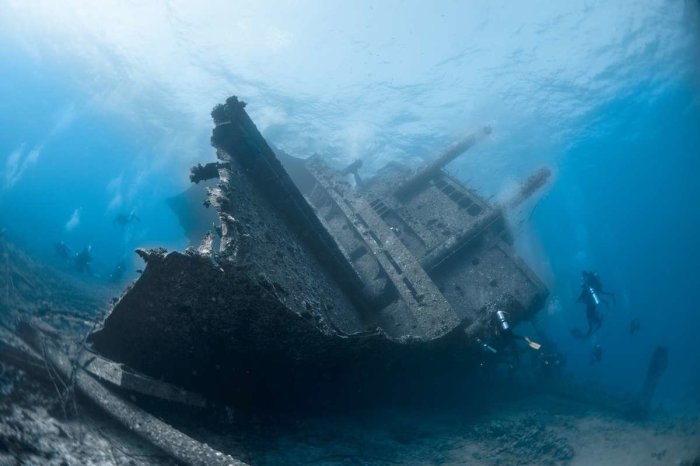
As we conclude our journey through the world’s scuba diving locations, let us remember the profound beauty and fragility of these underwater ecosystems. May we embrace responsible diving practices to preserve these precious realms for generations to come. May our dives always be filled with wonder, discovery, and a deep appreciation for the wonders that lie beneath the waves.
User Queries
What are some of the most popular scuba diving destinations?
The Great Barrier Reef, Maldives, Galapagos Islands, Red Sea, and Raja Ampat are among the world’s most renowned scuba diving destinations, offering diverse marine life, stunning coral formations, and unforgettable underwater experiences.
How can I choose the ideal scuba diving location for my experience level?
Consider your diving skills, interests, and preferences when selecting a scuba diving location. Research different destinations, consult with dive operators, and seek recommendations from experienced divers to find a site that aligns with your abilities and aspirations.
What are some essential safety measures to follow while scuba diving?
Proper training, equipment maintenance, dive planning, and adhering to dive limits are crucial for safe scuba diving. Always dive with a buddy, stay within your depth and experience level, and respect marine life and the underwater environment.